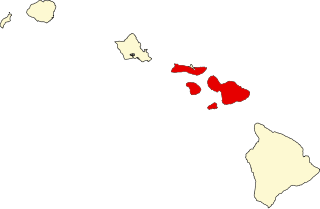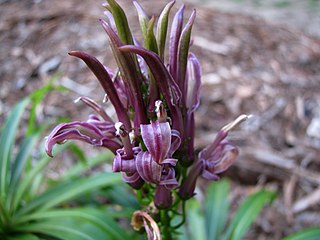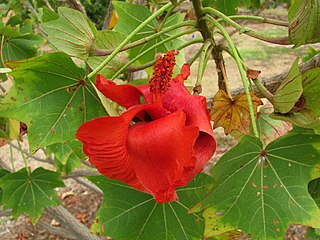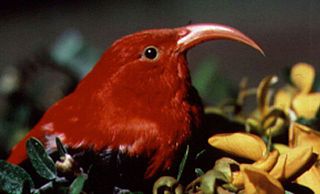
The ʻelepaios are three species of monarch flycatcher in the genus Chasiempis. They are endemic to the Hawaiian Islands, and were formerly considered conspecific. They measure 14 cm long and weigh 12–18 g. One species inhabits the Big Island, another Oʻahu and the third Kauaʻi. Being one of the most adaptable native birds of Hawaiʻi, no subspecies have yet become extinct, though two have become quite rare.

The nene, also known as the nēnē or the Hawaiian goose, is a species of bird endemic to the Hawaiian Islands. The nene is exclusively found in the wild on the islands of Oahu, Maui, Kauaʻi, Molokai, and Hawaiʻi. In 1957, it was designated as the official state bird of the state of Hawaiʻi.

The Anatinae are a subfamily of the family Anatidae. Its surviving members are the dabbling ducks, which feed mainly at the surface rather than by diving. The other members of the Anatinae are the extinct moa-nalo, a young but highly apomorphic lineage derived from the dabbling ducks.

The black geese of the genus Branta are waterfowl belonging to the true geese and swans subfamily Anserinae. They occur in the northern coastal regions of the Palearctic and all over North America, migrating to more southernly coasts in winter, and as resident birds in the Hawaiian Islands. Alone in the Southern Hemisphere, a self-sustaining feral population derived from introduced Canada geese is also found in New Zealand.

Flightless birds are birds that, through evolution, lost the ability to fly. There are over 60 extant species, including the well-known ratites and penguins. The smallest flightless bird is the Inaccessible Island rail. The largest flightless bird, which is also the largest living bird in general, is the ostrich.

Maui Nui is a modern geologists' name given to a prehistoric Hawaiian island and the corresponding modern biogeographic region. Maui Nui is composed of four modern islands: Maui, Molokaʻi, Lānaʻi, and Kahoʻolawe. Administratively, the four modern islands comprise Maui County. Long after the breakup of Maui Nui, the four modern islands retained plant and animal life similar to each other. Thus, Maui Nui is not only a prehistoric island but also a modern biogeographic region.

The moa-nalo are a group of extinct aberrant, goose-like ducks that lived on the larger Hawaiian Islands, except Hawaiʻi itself, in the Pacific. They were the major herbivores on most of these islands until they became extinct after human settlement.
The nēnē-nui or wood-walking goose is an extinct species of goose that once inhabited Maui and possibly Kauaʻi, Oʻahu and perhaps Molokaʻi in the Hawaiian Islands. It is known from a large number of subfossil bones found in Holocene cave sediments.

The Hawaiian lobelioids are a group of flowering plants in the bellflower family, Campanulaceae, subfamily Lobelioideae, all of which are endemic to the Hawaiian Islands. This is the largest plant radiation in the Hawaiian Islands, and indeed the largest on any island archipelago, with over 125 species. The six genera involved can be broadly separated based on growth habit: Clermontia are typically branched shrubs or small trees, up to 7 metres (23 ft) tall, with fleshy fruits; Cyanea and Delissea are typically unbranched or branching only at the base, with a cluster of relatively broad leaves at the apex and fleshy fruits; Lobelia and Trematolobelia have long thin leaves down a single, non-woody stem and capsular fruits with wind-dispersed seeds; and the peculiar Brighamia have a short, thick stem with a dense cluster of broad leaves, elongate white flowers, and capsular fruits. The relationships among the genera and sections remains unsettled as of April 2022.

Kokia cookei is a small, deciduous tree commonly known as the kokiʻo, Molokaʻi treecotton, Cooke's kokiʻo, or Molokaʻi kokiʻo.

The Maui parrotbill or kiwikiu is a species of Hawaiian honeycreeper endemic to the island of Maui in Hawaii. It can only be found in 50 square kilometres (19 sq mi) of mesic and wet forests at 1,200–2,150 metres (3,940–7,050 ft) on the windward slopes of Haleakalā. This species is critically endangered, with an estimated population in 2016 of 250-540 individuals, but more recent estimates of less than 150 individuals. Fossil evidence indicates that the bird could at one time be seen in dry forests at elevations as low as 200–300 metres (660–980 ft), as well as on the island of Molokaʻi.
The Maui Nui finch is an extinct member of the genus Telespiza in the family Fringillidae. It was endemic to the Hawaiian islands of Molokai and Maui. It is only known from fossil remains and likely became extinct before the first Europeans visited Hawaii in 1778.

Hawaiian honeycreepers are a group of small birds endemic to Hawaiʻi. They are members of the finch family Fringillidae, closely related to the rosefinches (Carpodacus), but many species have evolved features unlike those present in any other finch. Their great morphological diversity is the result of adaptive radiation in an insular environment. Many have been driven to extinction since the first humans arrived in Hawaii, with extinctions increasing over the last 2 centuries following European discovery of the islands, with habitat destruction and especially invasive species being the main causes.

Cyanea is a genus of flowering plants in the family Campanulaceae that are endemic to Hawaii. The name Cyanea in Hawaiian is hāhā.

Apteribis is an extinct genus of flightless birds in the ibis subfamily that was endemic to the Hawaiian Islands in the Pacific Ocean.

Thambetochen is an extinct genus of moa-nalo duck. It contains two species, the Maui Nui moa-nalo and the smaller O'ahu moa-nalo.

The turtle-jawed moa-nalo, also formerly referred to as the large Kauai goose, is a species of moa-nalo, which evolved in the Hawaiian Islands of the North Pacific Ocean. It was described in 1991 from subfossil material collected in 1976 by Storrs Olson from the calcareous Makawehi dunes on the south-eastern coast of the island of Kauai. Its remains have also been found at the nearby Makauwahi Cave site.

The small-billed moa-nalo, also known as the stumbling moa-nalo, is a species of moa-nalo, one of a group of extinct, flightless, large goose-like ducks, which evolved in the Hawaiian Islands of the North Pacific Ocean. It was described in 1991 from subfossil material collected in September 1982 by Storrs Olson, Helen James and others, from the Auwahi Cave on the southern slopes of Haleakalā, on the island of Maui.

The Oʻahu moa-nalo is one of two species of moa-nalo in the genus Thambetochen. Moa-nalo are a group of extinct, flightless, large goose-like ducks, which evolved in the Hawaiian Islands of the North Pacific Ocean.
















